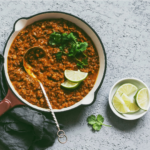Do you often find yourself with an empty fridge, looking for something healthy to feed the family? This lentil curry recipe is perfect. It takes no time at all, is loaded with goodness plus, it’s wholly plant-based so is a great go-to for meat-free Mondays!
This curry lentil recipe is simple and nutritious and best of all, inexpensive.
One of the dishes served at my sister’s lodge in South Africa is a moreishly delicious lentil curry and I always look forward to enjoying this when I visit. This is a version of their recipe, which I have tweaked to suit my children’s taste buds. It never tastes quite the same as it does when you’re eating this in the cool shade of the patio, with the sounds and smells of Africa enveloping you. Trust me though, this will soon become a regular feature at the family dinner table.

EXTRA VIRGIN OLIVE OIL
Virgin, extra virgin, oil, no oil? It’s so difficult to know which messages to listen to nowadays and views are ever-changing. Olive oil is high in monounsaturated fatty acids, what we call “good fats”. Good fats are so named because they have qualities that benefit us, as opposed to the trans and saturated fats that that saturate (erm, sorry, pun!) our diets today.
Olive oil also has a higher smoke point than many oils, which makes it good for mid-heat cooking. Oils are fragile and when heated up they change their composition and can become harmful to our bodies.
“What’s the big idea with the extra virgin, Julia?” I hear you ask. My rule of thumb is this: the less processing of a product, the closer it is to its natural form so therefore the less harmful it might be to my body (this is not science, you understand, it’s the world according to Julia). The more processes an oil goes through to prolong its shelf life (as well as being less likely to have held on to its flavour and nutritional elements), the further it is away from virgin. Therefore, extra virgin olive oil is less ‘fiddled with’ than regular olive oil. Also, if you can find “cold pressed” and “unfiltered” this is even better, but not in any way a deal breaker.
LENTILS
There are many varieties of lentil and each type lends itself to certain dishes. I prefer using French Puy lentils as they are creamy with a slightly peppery flavour and keep their shape well when cooked. However, standard green lentils are more readily available and also work well, albeit with a slightly softer texture especially if cooked too long.
The health benefits of lentils are well known – they are rich in protein, fibre and many essential minerals. A word of caution though – for some people with inflammatory gut conditions, lentils can exacerbate these symptoms so if you regularly feel unwell after eating lentils, steer clear.
CELERY
If a recipe calls for chopped onion as a base, I almost always add chopped celery to this too. Quick win – you get to add another vegetable to your dish, the flavour is unnoticeable when cooked as part of a larger dish and celery has great antioxidant and anti-inflammatory properties.
If you do buy celery, try to get organic, as it does appear on the Environmental Working Group’s Dirty Dozen list which means it tends to hold onto higher levels of pesticides. Having said that, some celery is better than none.
CARROTS
Although raw vegetables generally hold onto their nutrients better than cooked, cooking carrots increases the strength of carotenoids, the pigments that give bright yellow, orange and red colours to plants. Carotenoids can help to strengthen your immune system, have high anti-oxidant values and are also known to protect the healthy cells in your eye. Ever wonder where the old adage of carrots helping you to see in the dark came from?
PrintCurry Lentil Recipe
5 Stars 4 Stars 3 Stars 2 Stars 1 Star
No reviews
This dish is quick, simple and delicious and can be modified to suit any palate. It’s great when you need to clear out the fridge, so feel free to substitute or add any vegetables. The more, the merrier.
- Author: Julia Pratten
- Prep Time: 15 mins
- Cook Time: 45 mins
- Total Time: 1 hour
- Yield: 6
- Category: Main, Side
- Method: Oven
- Cuisine: Indian
- Diet: Vegan
Ingredients
- 1 tablespoon extra-virgin olive oil
- 1 large yellow onion, finely chopped
- 1 red pepper, finely diced
- 2 cloves garlic, crushed
- 2 sticks celery – sliced
- 3 carrots, grated
- 1 teaspoon curry powder
- 1 teaspoon ground cumin
- 1 teaspoon turmeric
- ¾ cup tomato puree
- 2 cups dry green lentils
- 6 cups (1.5 litres) liquid (I use vegetable broth)
- 1 bay leaf
- 2 teaspoons brown sugar
- Half a cup of chopped fresh parsley
- 2 tablespoons coconut cream (the thick layer on top of a tin of coconut milk)
- A pinch, grind, swish or sprinkle of salt
- To garnish – Half-bunch fresh chives or spring onions, sliced and chopped
Instructions
- Preheat oven to 180˚C/350˚F
- In a 5- or 6-quart oven-proof pot, heat the olive oil and butter. Add the onion and celery and saute for 3 – 4 minutes, until it begins to soften.
- Add the garlic and red pepper, give it a swirl and fry for a sauté for a further minute
- Add the curry powder, cumin and turmeric and fry over low heat for 2 minutes. Add the tomato puree and mix it well.
- Add the grated carrots, followed by the lentils, stock, sugar and bay leaf – mix well.
- Bring to a rapid simmer and then transfer to the over for 40 – 50 minutes.
- Check on the liquid levels after 30 minutes, as sometimes lentils can absorb water more or less rapidly. Give it a light stir and if it’s looking a bit dry, add more liquid. If it’s looking very watery then continue to bake with the lid off the pot.
- Remove from the oven, stir in the parsley and add the coconut cream.
- Leave the curry to cool for 10-15 minutes and sprinkle the chives on top just before serving.
Notes
I like to serve mine with brown rice or toasted naan bread. Fresh coriander, shredded coconut, chili flakes and mango chutney on the side add a lovely touch for diners to build their own bowl of deliciousness.
You can reheat up to 3 days after or freeze to enjoy at a later date. This dish tastes better the longer it sits, so it’s great to make on a Sunday and keep as a meal later in the week. Ideal vegan option (minus the butter) if you’re hosting a dinner party, as you can make this a few days before, knowing it’ll taste even better when you serve it up.









